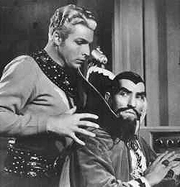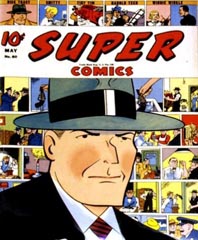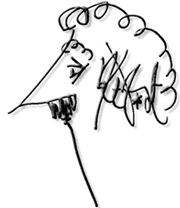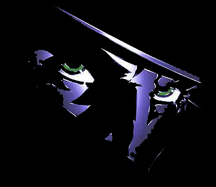DENNIS O’NEIL: Do You Believe In Magic?
 Here it is Tuesday evening and we’re still debating. Should we go to the 11:59 showing of the new Harry Potter flick at the local 21-plex or catch one of the early showings in the morning? Pros and cons on both sides. But we will see the movie within the next 24 hours; count on it.
Here it is Tuesday evening and we’re still debating. Should we go to the 11:59 showing of the new Harry Potter flick at the local 21-plex or catch one of the early showings in the morning? Pros and cons on both sides. But we will see the movie within the next 24 hours; count on it.
Although I’ve enjoyed the previous films, I can’t call myself a Potter fan. I haven’t read any of J.K. Rowling’s novels, though I love Ms Rowling’s bio: single mom writing in a café becomes hugely successful author, celebrity, and megamillionaire within about a decade, without becoming a robber baroness. But Marifran’s read the books. Oh yes indeed. And so have daughters Meg and Beth. So I’m pretty up on the Hogwarts scene and when the final volume in the series arrives in a couple of weeks, I expect my conversations with my wife to be conducted in monosyllables until she reaches the last page and learns Harry’s fate.
I’m surprised that these things are so popular, as I was surprised at the resurgence of interest in J.R.R. Tolkein’s Lord of the Rings saga and the huge success of the movies made from Tolkein’s trilogy. The reason is, I thought we were past believing in magic.
Oh, sure, you don’t have to actually believe in something to enjoy stories about it. But we do have to be able to accept it on some level. It helps the willing suspension of disbelief your English teacher told you is necessary to the enjoyment of fiction if you can allow that what you’re being told about exists, or could exist, or at least might have existed. Hero stories are about as old as civilization, and the tale-tellers always supply a reason why their protagonists have extraordinary powers. In classic Greece, for example, and later in Rome, superpowers were explained by their possessors either being gods, or half-gods, or children of gods, or gods’ special pals. Then plain ol’ magic, origin unknown, was used to rationalize superhuman feats in folk tales like those in A Thousand and One Nights.


 Last week, we were discussing the cons of continued stories, specifically what’s wrong with them, and we posited that they have a major problem in the difficulty new readers (or audiences) have in understanding the plot and characters. I said that there were remedies for this problem and now I’ll suggest, a bit timidly, that though remedies exist, nothing is foolproof.
Last week, we were discussing the cons of continued stories, specifically what’s wrong with them, and we posited that they have a major problem in the difficulty new readers (or audiences) have in understanding the plot and characters. I said that there were remedies for this problem and now I’ll suggest, a bit timidly, that though remedies exist, nothing is foolproof. Now, where were we…?
Now, where were we…? If you have ever suffered through one of my comics writing classes, or were lucky enough to take a Robert McKee film writing course, you know that some professional wordsmiths set a lot of store by structure, and that the most reliable structure is called the three act structure. (For more, and better, on this, see the recommended reading below.) I’m not about to presume to teach a class here, but most briefly – the three-act structure: 1, Something happens to cause the hero to act. 2. The problem gets complicated. 3. The hero resolves the problem.
If you have ever suffered through one of my comics writing classes, or were lucky enough to take a Robert McKee film writing course, you know that some professional wordsmiths set a lot of store by structure, and that the most reliable structure is called the three act structure. (For more, and better, on this, see the recommended reading below.) I’m not about to presume to teach a class here, but most briefly – the three-act structure: 1, Something happens to cause the hero to act. 2. The problem gets complicated. 3. The hero resolves the problem. (If) you’re…young; you don’t remember a time when continued stories were rare. But until Stan Lee made them standard procedure at Marvel in the 1960s, they were next to unheard-of.
(If) you’re…young; you don’t remember a time when continued stories were rare. But until Stan Lee made them standard procedure at Marvel in the 1960s, they were next to unheard-of. Which brings us to the pulp magazines, a publishing form that began about 1910 and was one with the dinosaurs by the middle 50s. A lot of these cheaply produced entertainments featured continuing heroes. (We’ve discussed perhaps the greatest of them, The Shadow, in this department
Which brings us to the pulp magazines, a publishing form that began about 1910 and was one with the dinosaurs by the middle 50s. A lot of these cheaply produced entertainments featured continuing heroes. (We’ve discussed perhaps the greatest of them, The Shadow, in this department 
 When we’re in a somber mood, which is an easy kind of mood to be in these days, we hope that Jerry Siegel and Joe Shuster were not prophets. Joe and Jerry were, of course, the creators of Superman, and way back in 1938 they told what’s become known as Superman’s origin story.
When we’re in a somber mood, which is an easy kind of mood to be in these days, we hope that Jerry Siegel and Joe Shuster were not prophets. Joe and Jerry were, of course, the creators of Superman, and way back in 1938 they told what’s become known as Superman’s origin story. All hail to thee, Pulpus. Praised be thy name.
All hail to thee, Pulpus. Praised be thy name. Back in the halcyon Sixties, when respectability was but a distant glimmer on science fiction’s horizon (and comics were still mired in disrepute), the editor of an SF magazine asked me to review a novel by Philip K. Dick. It wasn’t my first encounter with Mr. Dick; back in St. Louis, before I’d migrated east and gotten into the funny book racket, I’d read a roommate’s copy of Man in the High Castle and found it interesting. I told the editor, sure, be happy to. The book was Galactic Pot Healer. I didn’t like it and wrote the review accordingly.
Back in the halcyon Sixties, when respectability was but a distant glimmer on science fiction’s horizon (and comics were still mired in disrepute), the editor of an SF magazine asked me to review a novel by Philip K. Dick. It wasn’t my first encounter with Mr. Dick; back in St. Louis, before I’d migrated east and gotten into the funny book racket, I’d read a roommate’s copy of Man in the High Castle and found it interesting. I told the editor, sure, be happy to. The book was Galactic Pot Healer. I didn’t like it and wrote the review accordingly. Do my hands tremble as I type these words? Are there creaks and groans coming from the room behind me? Is the air chill and sticky?
Do my hands tremble as I type these words? Are there creaks and groans coming from the room behind me? Is the air chill and sticky? Kurt Vonnegut is gone.
Kurt Vonnegut is gone. I had it easier than many comics writers. I began in the business as an assistant to Stan Lee in 1965, when Marvel was just completing its metamorphosis from obscure Timely Comics to publishing phenomenon, and Stan’s vision of what a comic book company could be was pretty much complete. Implicit in the writing part of the job was the requirement that I imitate Stan’s style – after all, Stan’s style was Marvel. That made the job simple: imitate Mr. Lee successfully and I was doing it right.
I had it easier than many comics writers. I began in the business as an assistant to Stan Lee in 1965, when Marvel was just completing its metamorphosis from obscure Timely Comics to publishing phenomenon, and Stan’s vision of what a comic book company could be was pretty much complete. Implicit in the writing part of the job was the requirement that I imitate Stan’s style – after all, Stan’s style was Marvel. That made the job simple: imitate Mr. Lee successfully and I was doing it right.








